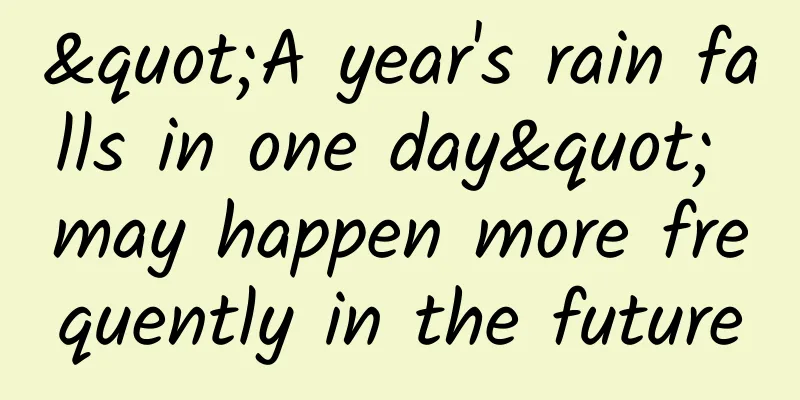"A year's rain falls in one day" may happen more frequently in the future

|
Recently, many parts of southern China have been hit by continuous heavy rainfall. Some areas of Guangdong, Fujian, Guangxi and other places have experienced moderate to heavy rain, with local torrential rain or heavy rain. (The above pictures are from China National Radio) (The above pictures are from Guilin Evening News) While paying attention to the disaster, we also heard some people in the disaster area express doubts, such as "It's too strange" and "It's never rained so hard before". We can undoubtedly feel the increase in the frequency of abnormal precipitation, but is this really the case? On what scales can we measure whether the precipitation is abnormal? First, let’s talk about “variability” Reports of extreme weather are not uncommon, so it seems that the extreme weather that occurs every year is not too "extreme", right? To solve this problem, we must first talk about the “variability” of weather and climate. Variability refers to the possible fluctuation or oscillation range of weather or climate, which can usually be expressed by standard deviation, and precipitation variability is a statistic used to express the degree of fluctuation of precipitation. For example, it rained yesterday but not today, which is the variability of precipitation on the weather scale ; in the summer of the year after El Niño, floods are prone to occur in the middle and lower reaches of the Yangtze River, and rainfall is higher than usual, which is the variability of precipitation on the interannual scale . Variability is closely related to extreme events. The greater the variability, the greater the intensity of extreme events. The expressions such as "once in N years" that everyone sees in the news media are called "return period" in climatology. This is a statistical concept that can be considered as the inverse of the probability of an event occurring. Generally speaking, the stronger the extreme event, the lower its probability of occurrence and the longer its recurrence period. The greater the variability of weather and climate, the higher the frequency of strong extreme events. Future rainfall: Uneven distribution is more a problem than insufficiency Many people find it unbelievable to imagine a year's worth of rain falling in one day, but this is not only possible, but will become more and more frequent. Because precipitation variability is increasing. The significant characteristics of the heavy rainfall process in Henan in July 2021 were strong short-term rainfall and prominent extreme rainfall. At that time, the maximum rainfall in Zhengzhou in 3 hours reached 333mm, which was more than half of its annual average total rainfall. The daily rainfall at Houzhai Meteorological Station in Erqi District was 692.2mm, which exceeded the annual average total rainfall in Zhengzhou. Whether it is "half of a year's rain falls in 3 hours" or "a year's rain falls in one day", what is reflected behind it is the increased variability of rainfall on the weather scale , that is, the temporal unevenness of rainfall. Why should we pay attention to precipitation variability on the weather scale? Because whether it is continuous or convective precipitation, it is directly related to the weather system on the weather scale. Even precipitation over a large area and for a long time is formed by a series of weather-scale systems, or by the long-term stagnation of a weather-scale system. Therefore, the weather-scale system is the first thing to pay attention to when analyzing and forecasting precipitation. Obviously, the same annual total precipitation of 641 mm (Zhengzhou) is very different in terms of catastrophicity when it falls evenly over 365 days and when it falls all at once in a few hours. What is worrying is that American scientists have found through climate change model research that if we adopt a high greenhouse gas emissions scenario without policy intervention in the future (RCP8.5, in which the total radiative forcing reaches 8.5W m-2 in 2100), by the end of this century (2085-2100), half of the global increase in precipitation will fall within 6 days. Coincidentally, another study on heavy rains in Europe found that under the background of global warming, the movement speed of convective systems that bring strong winds and rainstorms will slow down, which means that the storms will stay in a certain place for a longer time, causing local heavy rainfall and flooding disasters. The flood disaster in Germany in the summer of 2021 is a typical example. Image source: veer gallery In the context of global warming, the increase in precipitation variability on the weather scale means that the weather will fluctuate more widely. So, in addition to changes in variability on the weather scale, how will precipitation variability on other scales change? In a study published in Science Advances, Associate Researcher Zhang Wenxia from the Institute of Atmospheric Physics of the Chinese Academy of Sciences showed that as the climate warms, the world's humid areas (mainly including the tropics, most monsoon regions, and mid- and high-latitude regions) will become more humid due to an increase in total precipitation, while precipitation variability will also increase. We know that under the same air pressure, the total amount of water vapor that the atmosphere can hold is closely related to the temperature. A warmer atmosphere can "hold" more water vapor. As the world warms, the temperature gradually rises, the atmosphere will become more and more humid, and more water vapor can be converted into precipitation. Therefore, the total precipitation on Earth will become more "abundant" in the future. But at the same time, the temporal distribution of precipitation will become more uneven. On multiple time scales from weather to interannual, the variability of precipitation will increase with the increase in the magnitude of warming, which means that the fluctuations in precipitation between dry and wet periods will be more dramatic, and the Earth will face more frequent droughts and floods in the future. From the figure below, we can see that precipitation will show four possible changes in the future: most areas of the earth (including two-thirds of the land area) will become wetter and precipitation variability will increase (blue area); at the same time, other areas will face drying and increased precipitation variability (green area), wetter and reduced precipitation variability (red area), and drying and reduced precipitation variability (brown area). Changes in global precipitation under the background of climate warming. Most regions are dominated by blue, which means that total precipitation increases and precipitation variability increases (Chinese translation from citation 1) The study also pointed out that for every 1°C increase in global temperature, the global average precipitation variability will increase by about 5%, which is about twice the rate of average precipitation change. Why does precipitation have such big “mood fluctuations”? We know that rainfall is formed when rising air carries water vapor to high altitudes and the water vapor liquefies into raindrops due to the drop in temperature. The movement of air (atmospheric circulation) and the water vapor content in the atmosphere are the two main factors that determine precipitation changes. The study pointed out that under the background of future global warming, the atmospheric water vapor content will increase, and there will be more water vapor to support the occurrence of extreme precipitation, so the precipitation variability will increase; at the same time, the interaction between water vapor and circulation will also enhance precipitation variability. For example, more water vapor will release more latent heat when condensed, and this energy will further enhance the upward movement. Under this positive feedback mechanism, precipitation variability will be further enhanced. If we only consider the changes in water vapor, precipitation variability will increase more evenly across the globe in the future. However, due to the weakening of the variability of atmospheric circulation under the background of warming, under the combined influence of water vapor and circulation, global precipitation will eventually present four types of changes as shown in the figure above. Different combinations of changes in total precipitation and variability will cause different types of hydrological, agricultural and ecological impacts in different regions. For example, in areas where both total precipitation and variability increase, there will be abundant rainfall overall, but extreme precipitation and flooding events are more likely to occur, bringing greater challenges to the water conservancy system. People living in areas where the total amount of precipitation decreases but the variability increases may face both freshwater shortages and more frequent extreme floods and droughts. An increase in total precipitation with reduced variability may be the most desirable type of change, which means that the future rainfall will not only be abundant, but will also nourish the earth in a "silent" way. Unfortunately, almost no area in the world belongs to this type of change. It is worth noting that the precipitation change pattern in most parts of China is "wetter and more volatile", which means that the extremes of precipitation will increase and must attract our widespread attention. In summary, the Earth will not lack precipitation in the future, but more water vapor in the atmosphere will experience greater "emotional fluctuations", which will inevitably bring more dramatic dry-wet contrasts and flood disasters, which is consistent with the fact that droughts and floods have occurred frequently in the past two decades. In the context of warming, changes in precipitation variability will affect the climate resilience of society and ecosystems, and also pose new challenges to the response to climate change. The future is here, it’s not too late to change The IPCC's Sixth Assessment Report, Working Group I report "Climate Change 2021: The Physical Science Basis", released in 2021, pointed out that climate change caused by human activities is affecting extreme weather and climate in every region of the world, and continued global warming will further intensify the global water cycle, including its variability, global monsoon precipitation, and the severity of dry and wet events. The scale of recent changes in the entire climate system, and the current state of many aspects of the climate system, are unprecedented in past centuries and millennia, and are irreversible over the next centuries and millennia. There is a line in the movie "The Wandering Earth": "Initially, no one cared about this disaster. It was just a wildfire, a drought, the extinction of a species, the disappearance of a city, until this disaster was closely related to each of us..." Whether you care or not, the future has come, the earth has issued a warning, and changes are happening - Reducing the use of disposable tableware, recycling office paper, making full use of plastic products such as shopping bags, and low-carbon travel... These topics may seem old-fashioned, but if each of us can recognize the changes that are happening on the earth and start to make changes from ourselves, everyone's seemingly insignificant efforts will be the power of billions of people when combined. "The best time to plant a tree is ten years ago, and the second best time is now." It is not too late to respect the facts and make changes. References [1]Zhang Wenxia, Kalli Furtado, Peili Wu, Tianjun Zhou*, Robin Chadwick, Charline Marzin, John Rostron, David Sexton. 2021. Increasing precipitation variability on daily-to-multiyear timescales in a warmer world. Science Advances. DOI: 10.1126/sciadv.abf8021. [2]Pendergrass, AG, & Knutti, R. (2018). The uneven nature of daily precipitation and its change. Geophysical Research Letters, 45, 11,980– 11,988. https://doi.org/10.1029/2018GL080298 [3]Kahraman, A., Kendon, EJ, Chan, S., & Fowler, HJ (2021). Quasi-stationary intense rainstorms spread across Europe under climate change. Geophysical Research Letters, e2020GL092361. Planning and production Source: Science Academy (ID: kexuedayuan) Author: Zhang Wenxia Institute of Atmospheric Physics, Chinese Academy of Sciences Zhao Yin Chinese Meteorological Science Institute Editor: He Tong Proofread by Xu Lai and Lin Lin |
>>: Don’t wear these colors of swimsuits when swimming in summer, it’s really dangerous!
Recommend
Why do you spend so much money but the advertising effect is still so poor?
John, the founder of Ogilvy & Mather, express...
Adidas Migrates SAP Environment to Amazon Web Services to Digitally Transform Core Business
Transform your business and become a more data-dr...
Living in a presidential mansion and eating expensive koi! Are Singapore's otters doing so well?
Some time ago, Zouk Mum, the matriarch of Singapo...
Do you really understand colds?
When it comes to colds, everyone knows about it. ...
Artificial Intelligence Report: Scaling
Accenture has released a new report, “Artificial ...
"Makar" landed in Wenchang, Hainan, with wind speed exceeding 17! Keep this risk avoidance guide →
According to the Hainan Province Emergency Comman...
How to do fan marketing? Five methodologies for fan marketing!
% ignore_pre_1 % Luo Yonghao is the first generati...
WeChat official account adjustment: cancel the developer's customer service message sending quota in the payment scenario
On May 30, the WeChat public platform operation c...
With advertisements all over the screen, has Luckin Coffee made a comeback through marketing?
"Did you buy a whipped coconut latte today?&...
Weibo traffic | What is Weibo real-time account? What is it used for and how to raise it?
Why did you think of sharing this today? Because ...
Zhou Zhonghe, academician of the Chinese Academy of Sciences: Humanistic spirit is the "soul" of popular science
Academician Zhou Zhonghe 【Interview with Academic...
Tencent QQ updates! The "Beauty" function is launched. A young lady tested it and found that her legs were long in seconds.
Today, Tencent QQ officially announced that after...
Highlights of GMIC's first day: The big guys are absent and robots become the highlight
Although various industry conferences have become...
Learn about APP message push in ten minutes
Many friends have asked me how I write articles. ...
Insulation capacity +1! What kind of material is the silicone rubber used in the "Little Red Riding Hood" of electricity?
Recently, Chaoyang Power Supply Company of State ...









